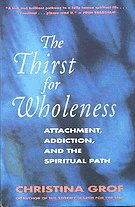The Thirst for Wholeness: Attachment, Addiction, and the Spiritual Path

Chapter headings:
- Introduction
- The Thirst for Wholeness
- The Craving Behind Addiction
- The Self and Wholeness
- Walking in the Desert
- Alienation, Abuse, and the Human Experience
- How do we Survive?
- The Dark Night of Addiction
- Surrendering and Being Surrendered
- Addiction and Attachment
- Healing and the path to the self
- The Promise of Healing and Spiritual Maturity
- Recovery, Rediscovery, and the Spiritual Path
- The Challenges and Pitfalls of the Path
- Acceptance and Forgiveness
- The Divine Experience of Being Human
- References
Selected excerpts:
“What gets us into trouble is our blind compulsion and our clinging. A couple of years ago, my friend Jack Kornfield, a gentle, skilled Buddhist teacher and a psychologist, gave me an article that appeared on the front page of our local newspaper. I chuckled when I read it because it demonstrated the lengths to which human beings will go in the attempt to satisfy our longings and transcend our limitations. In bold, black letters, was a headline: LICK TOADS AT YOUR OWN RISK. Its subtitle: Latest “High” Can Be Fatal. The text begins, “Here we go again. After cheap highs like glue sniffing and mushroom tripping, the latest way to catch a buzz is to lick a toad. Yes, you read that correctly.” But, says an expert in reptiles, “if you pick the wrong toad, you won’t only get high, you’ll get dead.” (p. 103)
“The most inspirational and authentic spiritual teachers usually appear to be very ordinary. They live outwardly simple lives, instructing their students and writing, cooking, gardening, feeding the animals, taking walks, working with others, or sitting in the same place day after day. Through their example, they teach about love, humility, strength, serenity, and wisdom. Spiritual literature is full of accounts of seemingly simple Zen masters, elders, rabbis, saints, or yogis who, through their actions, quietly and humorously lead seekers to their own truth.”
“One story describes a dedicated student of Judaism who sets out to meet a great rabbi. Along the way, he meets an old acquaintance on the road and tells him where he is going. “What are you going to learn from your master?” asks the friend. “I am not going to learn the Talmud [the holy scriptures],” the student replies, “I am going to see the way he ties his shoes.”
“There are many tales like this one. Each action and attitude, no matter what its magnitude, is significant. Mahatma Gandhi once said, “My life is my message.” The way in which we live our lives declares our message to the world.” (p. 264)
© 1993 Christina Grof
Order this book online at Amazon
The Buddhist Recovery Network does not officially endorse any of the book reviews that appear on this site. They are private viewpoints that may or may not represent the views of the organisation or its members. Readers are free to submit book reviews for publication on this site via the link below.
Reviews posted:
Paul –
This is a heartfelt look at recovery, very influenced by Buddhism, AA and transpersonal psychology (the influence of Jung is felt throughout). The book isn’t strictly Buddhist, but rather Buddhist-influenced, and introduces dukkha, The Four Noble Truths etc. It is great to hear the voice of a woman among these books. I started by thinking this would be a bit of a slog, as I have never found the marriage between Jung and Buddhism as inspiring as some other perspectives on Buddhism. Furthermore my hackles were raised when I saw the repeated TM (registered trademark) sign against her personalised therapy ‘Holotropic BreathworkTM’. I thought she must be some ambitious person trying to sell me something. However, I discovered that she is without question very genuine, and the book reveals a woman of great sensitivity and poetic sensibility. When she approaches topics like ‘the craving beneath the craving’, ‘surrender’ or ‘forgiveness’, she covers it from every angle so it really sinks in. The downside of this was that I found the intensity and earnestness of the tone and advice quite wearing, and much of it didn’t connect with my background, not having suffered from abuse. If you are a victim of abuse, you may find this book very powerful. One enduring message that has stayed with me, and to which we do owe a debt of gratitude to Jung, is how the journey of alcoholism can be seen as a misguided search for spirituality.
Michael –
The author reminds us in this book of a famous letter that Carl Jung wrote to Bill Wilson, one of the co-founders of AA. Jung quotes the powerful formula “spiritus contra spiritum”, or spirit (of the divine) heals the spirits (of alcohol). The author looks deeply at our desire for a sacred dimension that can give our lives meaning in our journey to recovery. Although she quotes from many spiritual traditions, this book seems strongly influenced by Buddhism. The essence of the Four Noble Truths is a starting point for this poignant exploration. She reminds us that in our craving everyone is ultimately an addict in one way or another, and those false refuges that we go to, be they active addiction, or even relationships and money, never truly make us happy. The search for spirit and the meaning it brings is what fills this hole within us. More than merely seeking outwards to traditional dogma and religion, we are told to reconnect with our own inner spiritual identity. Although there were some parts of this book that I personally did not relate to, in large part I found it to be a genuine and illuminating description of the journey and search for spiritual wholeness.
